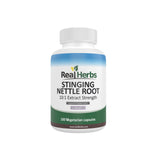What Does Stinging Nettle Roots Look Like?
Introduction
Stinging nettle (Urtica dioica) is a versatile plant known for its medicinal properties and culinary uses. While most people are familiar with its stinging leaves, the roots of stinging nettle also play a significant role in herbal medicine and natural remedies. In this article, we will explore the physical characteristics of stinging nettle roots, their importance in health practices, and tips for identifying them accurately.
Description of Stinging Nettle: Stinging nettle is a perennial plant that thrives in temperate regions around the world. It typically grows in moist, fertile soil and can reach heights of up to six feet. The plant has a square-shaped stem, heart-shaped leaves with serrated edges, and fine hairs on the surface that deliver a sting upon contact.
Understanding the Importance of Nettle Roots: While the leaves of stinging nettle are commonly used for their therapeutic properties, the roots are equally valuable. Nettle roots have been traditionally used in herbal medicine to address various health concerns. They are believed to possess anti-inflammatory, diuretic, and prostate-supportive properties. Furthermore, nettle root extracts and supplements are often utilized for their potential benefits in managing conditions such as arthritis, allergies, and urinary tract problems.
Physical Characteristics of Stinging Nettle Roots: Stinging nettle roots are typically light brown or yellowish in color. They can grow quite long, reaching depths of up to several feet in the soil. The roots often branch out, forming a complex network that helps anchor the plant and extract nutrients from the earth. When handling stinging nettle roots, it's essential to note that they may have tiny hairs similar to those found on the leaves. These hairs can cause skin irritation or a stinging sensation, so it's advisable to wear gloves or use protective measures when handling the roots.
Tips for Identifying Stinging Nettle Roots: To accurately identify stinging nettle roots, there are a few key characteristics to look out for. Firstly, the roots are generally light in color, distinguishing them from darker or reddish roots of other plants. Additionally, the branching patterns of the roots are quite intricate, forming a dense network that can help differentiate them from simpler root systems. When excavating stinging nettle roots, you may also encounter small, round structures known as tubers, which contribute to the plant's ability to propagate. However, it's important to note that these tubers should not be mistaken for the roots themselves.
Precautions and Safety: When handling stinging nettle roots, it's crucial to take precautions due to the plant's stinging hairs. These hairs can cause skin irritation and discomfort, especially for individuals with sensitivities or allergies. To minimize the risk, wear gloves or use a barrier when harvesting or handling the roots. If you experience any adverse reactions, such as itching or a rash, discontinue contact and wash the affected area with soap and water.
Conclusion: Stinging nettle roots are an integral part of this versatile plant, known for its medicinal and therapeutic properties. By understanding the physical characteristics of stinging nettle roots and following proper identification techniques, you can safely harness their potential health benefits. Whether you're interested in using nettle roots in herbal remedies or simply want to appreciate the plant's natural beauty, recognizing their distinct features will deepen your understanding and connection with this remarkable botanical resource.












